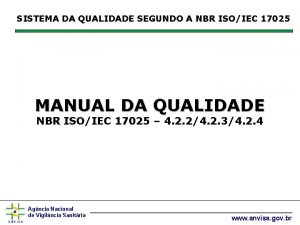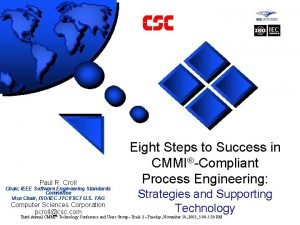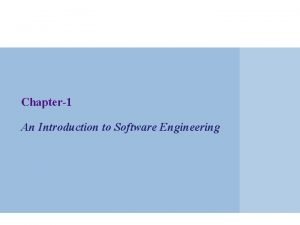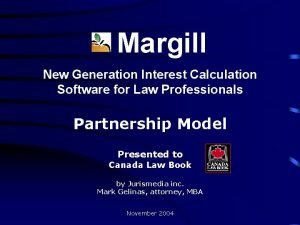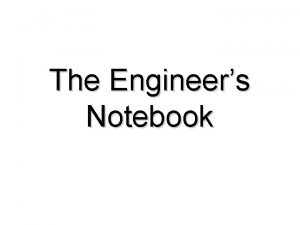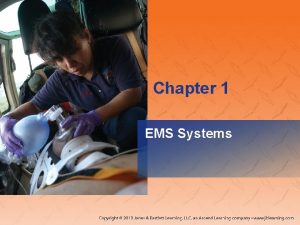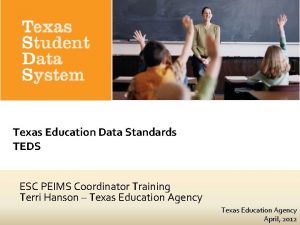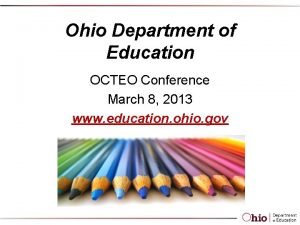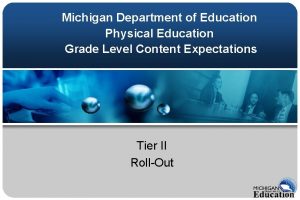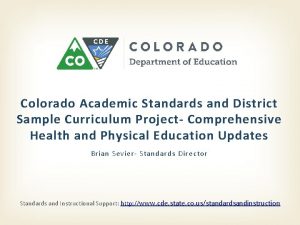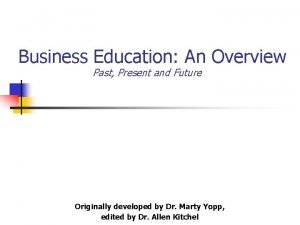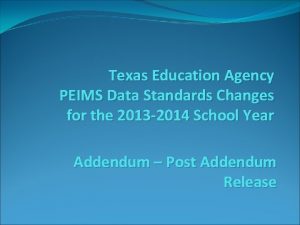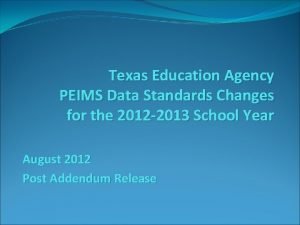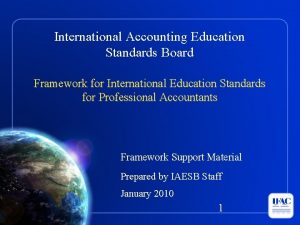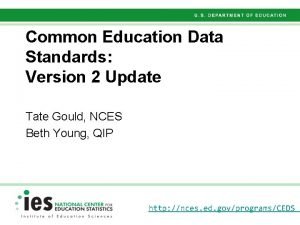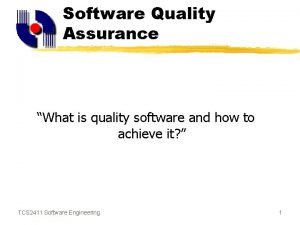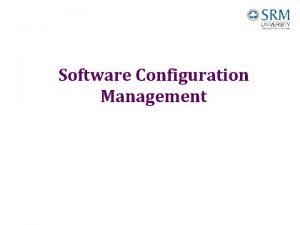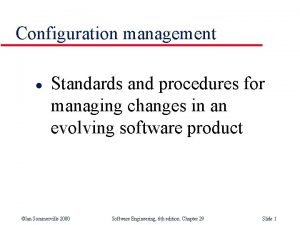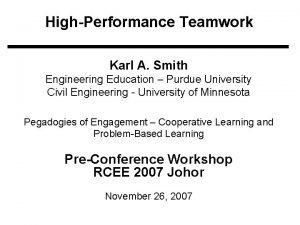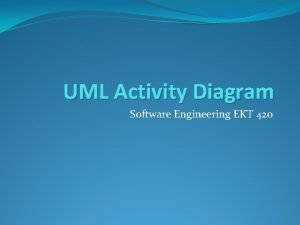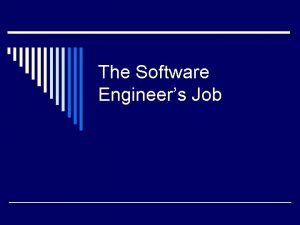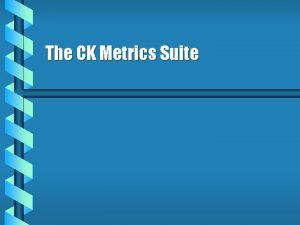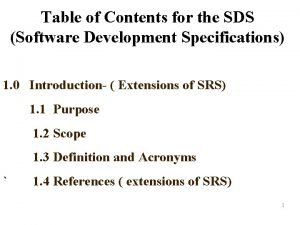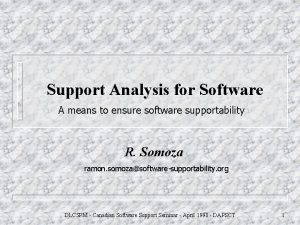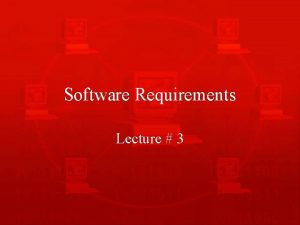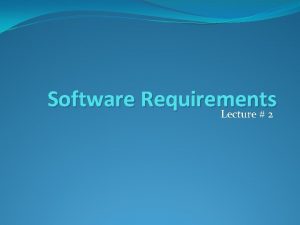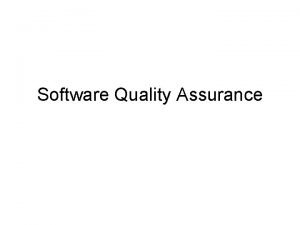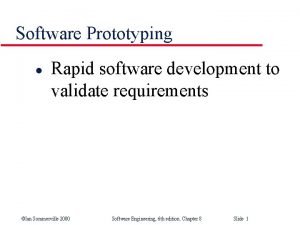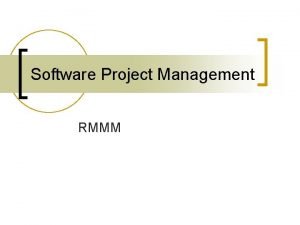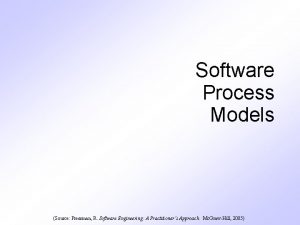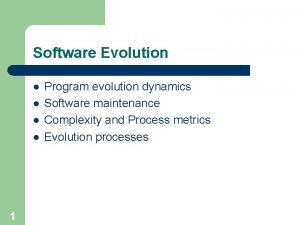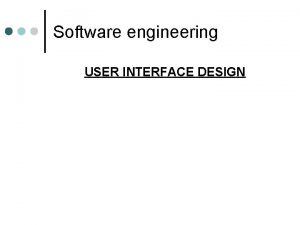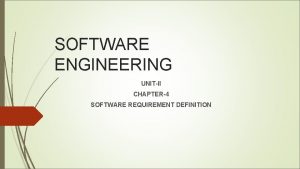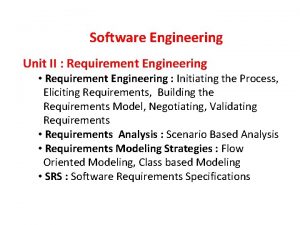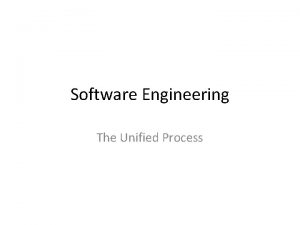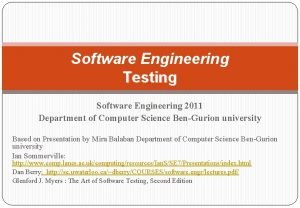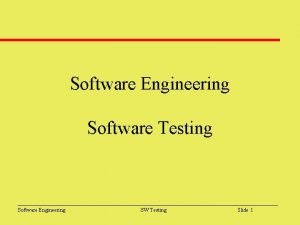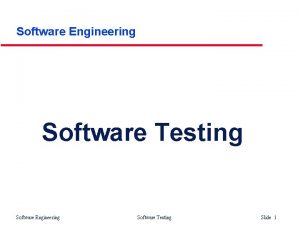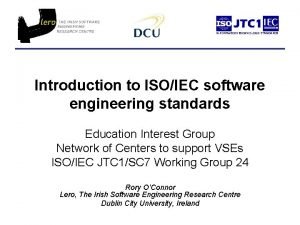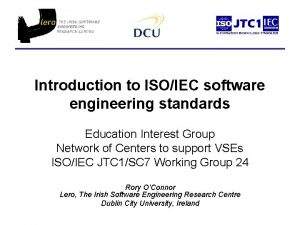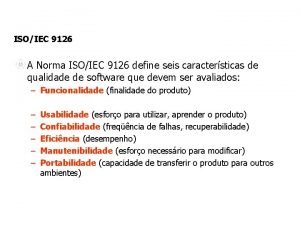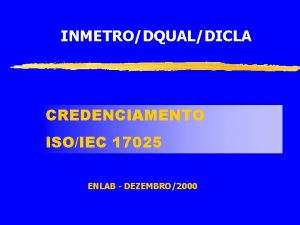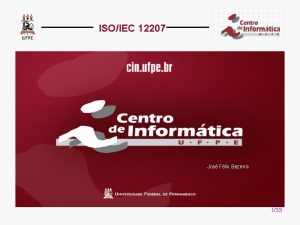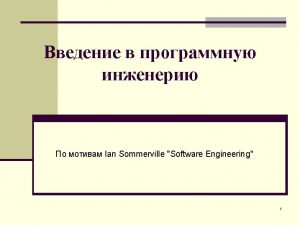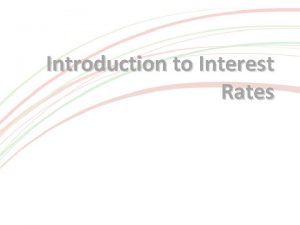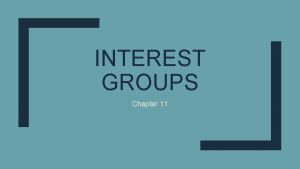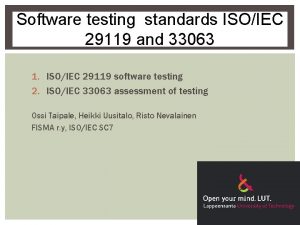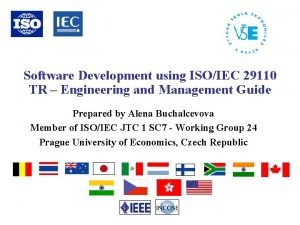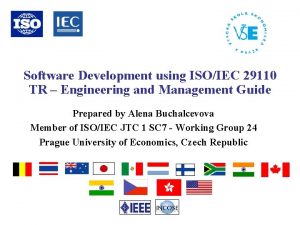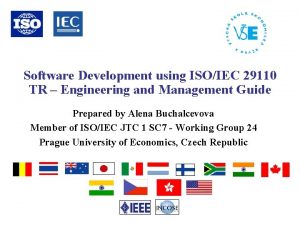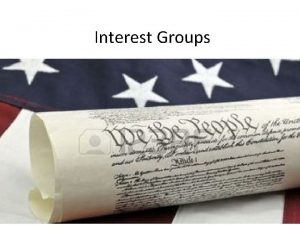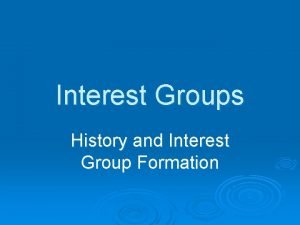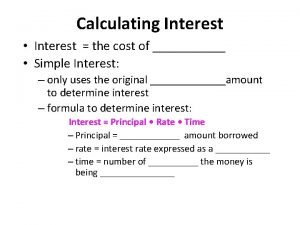Introduction to ISOIEC software engineering standards Education Interest











































































- Slides: 75

Introduction to ISO/IEC software engineering standards Education Interest Group Network of Centers to support VSEs ISO/IEC JTC 1/SC 7 Working Group 24 Rory O’Connor Lero, The Irish Software Engineering Research Centre Dublin City University, Ireland

Course description • This course provides the students with an introduction to the family of ISO/IEC Software Engineering Standards and describes the relationships between software engineering and systems engineering standards.

Objectives • Present the advantages and disadvantages of standards • Explain why ISO/IEC software engineering standards were developed • Explain the portfolio of ISO software and systems engineering standards and the relationships between systems engineering and software engineering ISO/IEC standards • Explain the ISO 9001 standards and associated guide for IT (ISO 90003) • Present the ISO/IEC 12207, 15504 standards

Target Audience • The course is for anyone new to ISO/IEC software engineering standards or those needing a refresher on the subject, such as: – Corporate engineering, manufacturing, and design staff – Quality managers – Government and public administration staff – University faculty and students (engineering, computer science, business, public policy, law) – Non-government organizations concerned with trade – Standards development organizations staff

Course Topics 1. 2. 3. 4. 5. 6. Why are Standards are important? What is ISO/IEC? What ISO/IEC Standards are available? ISO 9000 ISO 12207 ISO 15504

Why standards? • Quality orientated process approaches and standards are maturing and gaining acceptance in many companies • Standards emphasize communication and shared understanding – For example: if one person says, “Testing is complete”, will affected bodies understand what those words mean? • This kind of understanding is not only important in a global development environment; even a small group working in the same office might have difficulties in communication and understanding of shared issues • Standards can help in these and other areas to make the business more profitable because less time is spent on non-productive work

Benefits • The use of standards has many potential benefits for any organization – Improved management of software • Schedules and budgets are more likely to be met • Quality goals are likely to be reached • Employee training and turnover can be managed – Visible certification can attract new customers or be required by existing ones – Partnerships and co-development, particularly in a global environment, are enhanced 7

Importance of standards • Encapsulation of best practice – avoids repetition of past mistakes • Framework for quality assurance process – it involves checking standard compliance • Provide continuity – new staff can understand the organisation by the standards applied

Problems with standards • There is evidence that the majority of small software organizations are not adopting existing standards as they perceive them as being orientated towards large organizations. • Studies have shown that small firms’ negative perceptions of process model standards are primarily driven by negative views of cost, documentation and bureaucracy • it has been reported that VSEs find it difficult to relate standards to their business needs and to justify the application of the international standards in their operations

Course Topics 1. 2. 3. 4. 5. 6. Why are Standards are important? What is ISO/IEC? What ISO/IEC Standards are available? ISO 9000 ISO 12207 ISO 15504

Who is the ISO? • International Organization for Standardization is the world's largest developer of International Standards • ISO is a network of the national standards institutes of 162 countries, one member per country • ISO is a non-governmental organization that forms a bridge between the public and private sectors – Many of its member institutes are part of the governmental structure of their countries, or are mandated by their government – Other members have their roots uniquely in the private sector, having been set up by national partnerships of industry associations • This enables ISO to reach a consensus on solutions that meet both the requirements of business and the broader needs of society

Who develops ISO standards • ISO standards are developed by technical committees, (or subcommittees) comprising experts from the industrial, technical and business sectors • These experts may be joined by representatives of government agencies, consumer associations, non-governmental organizations and academic circles, etc. • Experts participate as national delegations, chosen by the ISO national member body for the country concerned.

How ISO standards are developed • The national delegations of experts of a committee meet to discuss, debate and argue until they reach consensus on a draft agreement • The resulting document is circulated as a Draft International Standard (DIS) to all ISO's member bodies for voting and comment • If the voting is in favor, the document, with eventual modifications, is circulated to the ISO members as a Final Draft International Standard (FDIS)

ISO Membership • Information about ISO, in general, is available on ISO Online (www. iso. org) • While a good deal of publicly accessible information concerning the technical work of the organization is maintained on the ISO TC Portal (www. iso. org/tc)

ISO/IEC outline Structure ISO IEC UN/ITU-T CS/ITTF TC 176 Quality Management JTC 1 Information Technology TC 56 SC 65 A Dependability Functional Safety SC 6 SC 7 SC 27 SC 37 Telecommunications Systems & Software Engineering IT Security Techniques Biometrics WGs ISO International Organization for Standardization IEC ITTF CS UN ITU-T TC SC JTC WG International Electrotechnical Commission Information Technology Task Force Central Secretariat United Nations International Telecommunications Union Technical Committee Sub Committee Joint Technical Committee Working Group

Subcommittees (SC) of ISO/IEC JCT 1 Technical Directions Application Technologies JTC 1 Subcommittees and Working Groups SC 36 - Learning Technology SC 02 - Coded Character Sets Cultural and Linguistic Adaptability SC 22/WG 20 – Internationalization & User Interfaces SC 35 - User Interfaces Data Capture land Identification Systems SC 17 - Cards and Personal Identification SC 31 - Automatic Identification and Data Capture Techniques Data Management Services SC 32 - Data Management and Interchange Document Description Languages SC 34 - Document Description and Processing Languages Information Interchange Media SC 11 - Flexible Magnetic Media for Digital Data Interchange SC 23 - Optical Disk Cartridges for Information Interchange Multimedia and Representation SC 24 - Computer Graphics and Image Processing SC 29 - Coding of Audio, Picture, Multimedia, Hypermedia Information Networking and Interconnects SC 06 - Telecommunications and Information Exchange Between Systems SC 25 - Interconnection of Information Technology Equipment Office Equipment SC 28 - Office Equipment Programming Languages & Software Interfaces SC 22 - Programming Languages, their Environments & Systems Software Interfaces Security SC 27 - IT Security Techniques Software Engineering SC 07 - Software and System Engineering Biometrics SC 37 - Biometrics

ISO/IEC JTC 1 SC 7 • ISO/IEC JTC 1 SC 7 – International Organization for Standardization/ International Electrotechnical Commission Joint Technical Committee 1 Sub-Committee 7 • ISO/IEC JTC 1 SC 7 Terms of Reference – “Standardization of processes, methods and supporting technologies for the engineering and management of software and systems throughout their life cycles”

SC 7 Structure SWG 5 SWG 1 Standards Management Group SC 7 Business Planning Group Secrétariat WG 1 A IT Governance WG 2 Systems & Software Documentation WG 4 Tools and Environment WG 6 Software Product Measurement and Evaluation WG 7 Life Cycle Management WG 10 Process Assessment WG 19 Techniques for Specifying IT Systems WG 20 Software Engineering Body of Knowledge WG 25 WG 21 Software Asset Management WG 22 IT Service Management WG 26 Vocabulary WG 23 Software Testing WG 42 Systems Quality Management WG 24 Architecture JWG ISO/TC 54 SLC Profiles and Guidelines for VSEs CIF Usability ‡ Adapted from Prof. M. Azuma

Working Group 24 • ISO/IEC JTC 1/SC 7 WG 24, Life Cycle Processes for Very Small Entities • ISO 29110 • The goal of Working Group 24, to: – “develop profiles, guides, and examples to assist very small enterprises to become more competitive” • WG 24 is planning to develop several products to give small entities a better opportunity to develop high-quality products on time and to make a profit in the process. • Creating an overview, framework, profile, and taxonomy, leading to a standard that will enable development of guides for engineering, management, and assessment

Course Topics 1. 2. 3. 4. 5. 6. Why are Standards are important? What is ISO/IEC? What ISO/IEC Standards are available? ISO 9000 ISO 12207 ISO 15504

What ISO/IEC Standards are available? • There a large collection of standards covering a range of domains • For example: – ISO 9126 for the evaluation of software quality – ISO 20926 a functional size measurement method – ISO 26513 for testers and reviewers of user documentation

Domains covered by SC 7 Project Management Industrial Engineering Quality Management (ISO TC 176) SOFTWARE and SYSTEMS ENGINEERING Computer Sciences and Engineering Dependability Engineering (IEC TC 56) APPLICATION DOMAINS (many TCs) Safety (IEC TC 65), Security, other mission-critical

JTC 1 SC 7 Standards Collection

Course Topics 1. 2. 3. 4. 5. 6. Why are Standards are important? What is ISO/IEC? What ISO/IEC Standards are available? ISO 9000 ISO 12207 ISO 15504

ISO 9000 Philosophy • Document what you do – in conformance with the requirements of the applicable standard • Do what you document • Record what you did • Prove it – maintenance of registration requires audits every three years, with mini-audits every six months

The ISO 9000 Family • ISO 9000 is a family of standards for quality management systems • Originated in manufacturing, they are now employed across a wide range of other types of organizations • Some of the requirements in ISO 9001 (which is one of the standards in the ISO 9000 family) include – – a set of procedures that cover all key processes in the business; monitoring processes to ensure they are effective; keeping adequate records; checking output for defects, with appropriate corrective action where necessary; – regularly reviewing individual processes and the quality system itself for effectiveness; and – facilitating continual improvement

What is in the ISO 9000 Family • ISO 9000 -1 is a general guideline which gives background information about the family of standards • ISO 9001, ISO 9002, and ISO 9003 are standards in the family, containing requirements on a supplier • ISO 9002 and ISO 9003 are subsets of ISO 9001 – ISO 9002 applies when there is no design – ISO 9003 applies when there is neither design nor production • ISO 9004 is a comprehensive guideline to the use of the ISO 9000 standards • For software development, ISO 9001 is the standard to use • ISO 9000 -3 is a guideline on how to use ISO 9001 for software development • ISO 9004 -2 is a guideline for the application of ISO 9001 to the supply of services (including computer centers and other suppliers of data services)

ISO 9000 Structure ISO 9000 ISO 9002 ISO 9001 Quality System Model for Quality Assurance in design, development, production, installation and service ISO 9000 -3 Quality System Model for Quality Assurance in production, installation, and servicing Guidelines for the application of ISO 9001 to the design, development and maintenance of software ISO 9003 Quality System Model for Quality Assurance in final inspection and test

Quality management • ISO 9001 is for quality management. • Quality refers to all those features of a product (or service) which are required by the customer. • Quality management means what the organization does to – ensure that its products or services satisfy the customer's quality requirements and – comply with any regulations applicable to those products or services. • Quality management also means what the organization does to – enhance customer satisfaction, and – achieve continual improvement of its performance

Generic standard • ISO 9001 is a generic standard • Generic means that the same standards can be applied: – to any organization, large or small, whatever its product or service, – In any sector of activity, and – whether it is a business enterprise, a public administration, or a government department. • Generic also signifies that – no matter what the organization's scope of activity – if it wants to establish a quality management system, ISO 9001 gives the essential features

Management systems • Management system means what the organization does to manage its processes, or activities in order that – its products or services meet the organization’s objectives, such as – satisfying the customer's quality requirements, – complying to regulations • Everyone is clear about who is responsible for doing what, when, how, why and where. • Management system standards provide the organization with an international, state-of-the-art model to follow.

Processes, not products • ISO 9001 concern the way an organization goes about its work – Its not a product standard – Its not a service standard – It’s a process standard • It can be used by product manufacturers and service providers. • Processes affect final products or services. • ISO 9001 gives the requirements for what the organization must do to manage processes affecting quality of its products and services

ISO 9000 Process model

ISO 9000 and Quality Management ISO 9000 quality models is instantiated as Organization quality process Organization Quality manuals For assessment Is used to develop Project 1 Quality plan Project 2 Quality plan supports Project 3 Quality plan Project quality management

Certification and registration • Certification is known in some countries as registration. • It means that an independent, external body has audited an organization's management system and verified that it conforms to the requirements specified in the standard (ISO 9001 or ISO 14001). • ISO does not carry out certification and does not issue or approve certificates,

Accreditation • Accreditation is like certification of the certification body. • It means the formal approval by a specialized body - an accreditation body - that a certification body is competent to carry out ISO 9001 certification in specified business sectors. • Certificates issued by accredited certification bodies and known as accredited certificates - may be perceived on the market as having increased credibility. • ISO does not carry out or approve accreditations.

Certification not a requirement • Certification is not a requirement of ISO 9001 • The organization can implement and benefit from an ISO 9001 system without having it certified • The organization can implement them for the internal benefits without spending money on a certification programme

Certification is a business decision • Certification is a decision to be taken for business reasons: – – if it is a contractual, regulatory, or market requirement, If it meets customer preferences it is part of a risk management programme, or if it will motivate staff by setting a clear goal.

ISO does not certify • ISO does not carry out ISO 9001 certification • ISO does not issue certificates • ISO does not accredit, approve or control the certification bodies • ISO develops standards and guides to encourage good practice in accreditation and certification

Certification Process Make commitment Select Registrar Conduct full assessment Enter surveillance mode Apply for registration Perform pre/internal assessment audit Conduct initial assessment/doc review Make improvements/take corrective action

Course Topics 1. 2. 3. 4. 5. 6. Why are Standards are important? What is ISO/IEC? What ISO/IEC Standards are available? ISO 9000 ISO 12207 ISO 15504

ISO/IEC 12207 • Is an international software engineering standard that defines the software engineering process, activity, and tasks that are associated with a software life cycle process from conception through retirement • The standard has the main objective of supplying a common structure so that the buyers, suppliers, developers, maintainers, operators, managers and technicians involved with the software development use a common language • It aims to be 'the' standard that defines all the tasks required for developing and maintaining software

What is it? • A standard for software lifecycle processes • A standard that provides a common framework to speak the same language in software discipline. – For the first time - a world-wide agreement on what activities make up a software project • The processes in the life cycle of software – – High level process architecture Activities and tasks Tailored for any organization or project An ‘inventory’ of processes from which to choose

What is it NOT? • NOT a standard for product – Does not measure the quality of the product • NOT prescriptive – Does not say specifically how to do things • NOT a standard for methods – Does not prescribe to specific lifecycle or tools

ISO 12207 • Standard ISO 12207 establishes a process of life cycle for software, including processes and activities applied during the acquisition and configuration of the services of the system – Each Process has a set of outcomes associated with it. – There are 23 Processes, 95 Activities, 325 Tasks and 224 Outcomes

ISO 12207 Process Architecture • Purpose – high level objective of performing the process and the likely outcomes of effective implementation of the process • Outcomes – An achievable result of the successful achievement of the process purpose – 224 outcomes • Process – a set of related activities, which transform inputs to outputs – 25 processes (18 + 7 new) • Activity – detailed set of tasks – 95 Activities • Task – action which inputs and outputs – 325 tasks

Software life cycle processes SUPPORTING PROCESSES PRIMARY PROCESSES Acquisition Preparation Supplier selection Supplier management Customer acceptance Supply Requirements elicitation Operation System operation Customer support Development System analysis and design Software requirements analysis Software design Software implementation Software integration Software testing System integration and testing Maintenance ORGANISATIONAL PROCESSES Management Project Management Quality Management Risk Management Documentation Configuration Management Quality Assurance Verification Validation Joint Review Audit Problem Resolution Infrastructure Organisational alignment Improvement Process establishment Process assessment Process improvement Human Resource Management Measurement Reuse

Sub-processes Process Requirements implementation elicitation System requirements analysis System architectural design Software requirements analysis Project System Software installation System integration Software design Software integration Software construction Software acceptance support System testing Software testing

Sub-processes • For example… – Some Sub-Processes in more detail • Process implementation • Requirements elicitation • System requirements analysis

Process implementation • Define or select software life cycle model appropriate to the scope, magnitude, and complexity of the project; • Select, tailor, and use standards, methods, tools, and programming languages (if not stipulated in contract); • Develop plans for conducting the activities of the Development process.

Requirements elicitation • Purpose: – to gather, process, and track evolving customer needs and requirements throughout the life of the product and/or service so as to establish a requirements baseline that serves as the basis for defining the needed work products. – Requirement elicitation may be performed by the acquirer or the developer of the system. • Tasks: – – – Obtain customer requirements and requests Review to Understand customer expectations Agree on requirements Establish customer requirements baseline Manage customer requirements changes • Outputs: – Customer requirements; – Change request records.

System requirements analysis • Purpose: – to transform the defined stakeholder requirements into a set of desired system technical requirements that will guide the design of the system. • Tasks: – – Establish system requirements Establish and maintain traceability Verify system requirements Baseline and communicate system requirements • Outputs: – System requirements; Interface requirements; – Traceability record – Verification report


Course Topics 1. 2. 3. 4. 5. 6. Why are Standards are important? What is ISO/IEC? What ISO/IEC Standards are available? ISO 9000 ISO 12207 ISO 15504

What is it? • ISO/IEC 15504, also known as SPICE (Software Process Improvement and Capability Determination), is a framework for the assessment of processes

Process Assessment • An appraisal or review of an organisations software process – The disciplined examination of the processes by an organisation against a set of criteria to determine capability of those processes to perform within quality, cost and schedule goals • It helps organisations improve themselves by identifying their critical problems and establishing improvement priorities • Not an end in itself • Feeds to an improvement plan

Why perform an assessment? • To understand determine the organisations current software engineering practices and to learn how the organisation works • To identify strengths, major weaknesses and key areas for SPI • Facilitate the initiation and planning of SPI activities and enrol leaders in change process • To help obtain sponsorship and support for actions through following a participative approach to assessment • External factors - requirement to have an “official” maturity level rating • When you start working with improvement you need to know – the state of the organisations current software process – and the goals for the future – You also need to know whether you have reached your goals when the planned improvement activities are finished

Contexts for Process Assessment Process Is subjected to Identifies changes to Process Improvement Process Assessment leads to may lead to Identifies suitability of Capability Determination

The International Standard Part 1 Concepts and Vocabulary Part 3 Guidance on Performing Assessments Compliant Process Reference Model (ISO/IEC 12207 AMD 1/2) Part 2 Requirements (normative) Part 5 An Exemplar Assessment Model Part 4 Guidance on Using Assessment Results

The Process Assessment Process PROCESS REFERENCE MODEL Domain and Scope Process Purpose Process Outcomes INPUT Sponsor identity Purpose Scope Constraints Assessment Team PROCESS ASSESSMENT MODEL Scope Indicators Mapping Translation ASSESSMENT PROCESS Planning Data Collection Data Validation Process Attribute Rating Reporting ROLES AND RESPONSIBILITIES Sponsor Competent Assessors MEASUREMENT FRAMEWORK Capability Levels Process Attributes Rating Scale OUTPUT Identification of Evidence Process Used Process Profiles

The Assessment Framework • Two-dimensional model for processes and process capability – Process Dimension • Process Categories • Processes (P 1, …, Pn) – Capability Dimension • Capability Levels (CL 1, …, CL 5) • Process Capability Attributes • Each process receives a capability level rating CL 5 CL 4 CL 3 CL 2 CL 1 CL 0 CUS. 1 CUS. 2. . . ORG. 6

A Measurement Scale of Capability • Process capability is defined on a six point ordinal scale of measurement – the bottom of the scale: the Incomplete Process • Performance that is not capable of fulfilling its goals – the top of the scale: the Optimising Process • Performance that is capable of meeting its goals and sustaining continuous process improvement • The scale represents increasing capability of the process

ISO/IEC 15504 -5: Processes Acquisition preparation Supplier selection Contract agreement Supplier monitoring Product acceptance Supply Supplier tendering Product release Product acceptance support Engineering Requirements elicitation System requirements analysis System architectural design Software requirements analysis Software design Software construction Software integration Software testing Software installation System integration System testing System and software maintenance Configuration Control Management Documentation management Configuration management Problem resolution management Change request management Organisational alignment Organisational management Project management Quality management Risk management Measurement Product Quality Product evaluation Quality Assurance Quality assurance Verification Validation Joint review Audit SUPPORTING ORGANISATIONAL PRIMARY Process Improvement Process establishment Process assessment Process improvement Resource and Infrastructure Human resource management Training Knowledge management Infrastructure Reuse Asset management Reuse program management Domain engineering

The Measurement Framework Optimizing The process is continuously improved to meet relevant current and projected business goals Level 5 PA. 5. 1 PA. 5. 2 Predictable The process is enacted consistently within defined limits Level 4 PA. 4. 1 PA. 4. 2 Established A defined process is used based on a standard process. Level 2 PA. 2. 1 PA. 2. 2 Level 1 PA. 1. 1 Level 0 Level 3 PA. 3. 1 PA. 3. 2 Incomplete Predictable Process Measurement Process Control Process Definition Process Deployment Performance Management Work Product Management Process Performance Process Innovation Process Optimisation Established Managed Performed Optimizing Managed The process is managed and work products are established, controlled and maintained. Performed The process is implemented and achieves its process purpose Incomplete The process is not implemented or fails to achieve its purpose

The Assessment framework • The formal entry to the assessment processes occurs with the compilation of the assessment input – This defines the purpose of the assessment (why it is being carried out), the scope of the assessment (which processes are to be assessed) and what constraints, if any, apply to the assessment • An assessment is carried out by assessing selected processes against the process model • The assessment output includes a set of process capability level ratings for each process instance assessed. • An assessment is supported by an assessment instrument – The process assessment is carried out either by a team with at least one qualified assessor; or, on a continuous basis using suitable tools for data collection and verified by a qualified assessor.

The Assessment Framework Assessment Tool Process Reference Model Process Assessment Model Output Input - Purpose - Scope - Constraints Assessor Training Syllabus & Certification Scheme Process Assessment Responsibilities Competent Assessor Sponsor Assessors 5 4 3 2 1 Process Improvement or Capability Determination Guidance

The Assessment Model ISO 15504 -2 Requirements for Conformity (Compatibility) Measurement Framework determine applicability of Assessment Model Requirements for Compliance determine suitability of Process Reference Model e. g. ISO 12207

Process Assessment Models • A Process Assessment Model forms the basis for the collection of evidence and rating of process capability. • Any Process Assessment Model is related to one or more Process Reference Models. • A Process Assessment Model shall contain: – a definition of its purpose, scope, elements and indicators; – its mapping to the Measurement Framework and the specified Process Reference Model(s); – a mechanism for consistent expression of results.

Why the concern for Conformance? • Results from assessments based on the same assessment model can generally be compared in some way. • The requirements for conformance of assessment models broadens the basis for comparison: – assessments based on different assessment models can be compared, providing the models can be related to the same Process Reference Model.

Process Reference Models 15504 Requirements REQUIREMENTS Performing an assessment Process Reference Models Process Assessment Models Conformity assessment Model Architecture Process Categories Process Capability Levels Reference Processes Model Process Attributes requirements 15504 Assessment Model OOSPICE Automotive SPICE ISO 9001 S 9 K

Additional Information

Acronyms A AG AH AIP AMD CD C/HOD CIF D DCOR DIS DTR E FCD FDIS FDAM FPDISP FT FTDIS GE GT IS Agreed (Comment Resolution) Advisory Group Ad hoc (groups) Agreed in Principle (Comment Resolution) Amendment Committee Draft Convenor/Head of Delegation Common Industry Format Deferred (Comment Resolution) Draft Corrigenda Draft International Standard Draft Technical Report Editorial (Comment Resolution) Final Committee Draft Final Draft International Standard Final Draft Amendment Final Proposed Draft International Standardized Profile Fast-Track Draft International Standard General Editorial (Comment Resolution) General Technical (Comment Resolution) International Standard IEC ISP ISO JTC JWG NP OBE ODP PAS PDAM PDTR PWI R SC SG SWG TH TL TR TS W WD WG International Electrotechnical Commission International Standardized Profile International Organization for Standards Joint Technical Committee Joint Working Group New Work Item Proposal Overtaken by Events (Comment Resolution) Open Distributed Processing Publicly Available Specification Proposed Draft Amendment Proposed Draft Technical Report Proposed Work Item Reject (Comment Resolution) Sub-committee Sub-Group Special Working Group Technical High (Comment Resolution) Technical Low (Comment Resolution) Technical Report Technical Specification Withdrawn (Comment Resolution) Working Draft (Working Group Draft) Working Group

Information Links • SC 7 website – http: //www. jtc 1 -sc 7. org/ • Procedures for the technical work of ISO/IEC JTC 1 on Information Technology (Ed. 5) takes precedence over the ISO directives for Standards Development – http: //isotc. iso. org/livelink. exe/fetch/186605/customview. html? func=ll&obj. Id=186605& obj. Action=browse&sort=name • ISO Directive for Standards Development – http: //isotc. iso. org/livelink/fetch/2000/2122/3146825/4229629/texts_list. htm – Part 1 of the ISO/IEC Directives, together with this Supplement, provide the complete set of procedural rules to be followed by ISO committees • • http: //isotc. iso. org/livelink. exe? func=ll&obj. Id=4230452&obj. Action=browse&sort=subtype Special procedures, i. e. , guidance, associated with the development of standards have been developed based on experience are listed at the following: – http: //isotc. iso. org/livelink/fetch/2000/2122/3146825/4229629/sds_spec. htm • Procedures for writing standards, ISO/IEC Directives, Part 2, Rules for the structure and drafting of International Standards (Ed. 5) and associated guidance is provided at the following: – http: //isotc. iso. org/livelink/fetch/2000/2122/3146825/4229629/sds_spec. htm • SC 7 draft standards balloting information and schedule is available at: – http: //142. 137. 17. 56/Labo_Recherche/Lrgl/sc 7/Ballots. html

ISO Document Life Cycle EXISTING STANDARD NP ISO Standard WD CD PDAM FCD FPDAM FDIS FDAM IS PDTR AMD Non-ISO Standard Fast track process PDISP FPDISP DTR TR SC 7 develops SC 7 controls ISO edits and publishes Adapted from: SC 7 Secretariat Training for ISO Editors, Hyderabad 2009 FDISP DCOR DIS ISP COR IS NP = New work item Proposal WD = Working Draft CD = Comittee Draft FCD = Final Comittee Draft FDIS = Final Draft International Standard IS = International Standard TR = Technical Report

Evolution of SC 7 Portfolio 110 100 Standards Published 90 Standards Maintained 80 70 60 50 40 30 20 10 0 1987 1989 1991 1993 1995 1997 1999 2001 2003 2005 2007 2009
 Isoiec
Isoiec Ieee software engineering standards
Ieee software engineering standards What is real interest rate and nominal interest rate
What is real interest rate and nominal interest rate Effective interest rate formula
Effective interest rate formula Simple interest
Simple interest System procurement process in software engineering
System procurement process in software engineering Forward engineering and reverse engineering
Forward engineering and reverse engineering Software maintenance in software engineering ppt
Software maintenance in software engineering ppt What is software implementation in software engineering
What is software implementation in software engineering Metrics computer science
Metrics computer science Example of software crisis
Example of software crisis Examples of product metrics
Examples of product metrics Real time software design in software engineering
Real time software design in software engineering Design principles in software engineering
Design principles in software engineering Introduction to software engineering
Introduction to software engineering Software engineering 1 course outline
Software engineering 1 course outline Factors determining service standards
Factors determining service standards Interest calculation software
Interest calculation software Interest calculation software
Interest calculation software Standard drawing scales
Standard drawing scales Engineers notebook
Engineers notebook National ems education standards
National ems education standards Texas education data standards
Texas education data standards Ohio tpes
Ohio tpes Michigan grade level content expectations
Michigan grade level content expectations National science education standards inquiry
National science education standards inquiry Colorado physical education standards
Colorado physical education standards Future of business education
Future of business education Oklahoma 3rd grade math standards
Oklahoma 3rd grade math standards Texas education data standards
Texas education data standards Performance standards examples education
Performance standards examples education Peims data standards
Peims data standards California state standards physical education
California state standards physical education International accounting education standards board
International accounting education standards board Career education standards 3-18
Career education standards 3-18 Dese physical education standards
Dese physical education standards Common education data standards
Common education data standards Texas education data standards
Texas education data standards Iso 9001 software quality assurance
Iso 9001 software quality assurance Scm meaning in software
Scm meaning in software Software configuration management basics and standards
Software configuration management basics and standards Dicapine
Dicapine Elegant systems
Elegant systems Reverse engineering vs forward engineering
Reverse engineering vs forward engineering What is cdio
What is cdio European society for engineering education
European society for engineering education Engineering education purdue
Engineering education purdue Difference between als and formal education
Difference between als and formal education Differentiate between health education and health promotion
Differentiate between health education and health promotion Types of extension education
Types of extension education Computer architecture lab experiments
Computer architecture lab experiments User interface in software engineering
User interface in software engineering Srs software engineering
Srs software engineering Activity diagram generator
Activity diagram generator Software engineering task
Software engineering task Project management spectrum
Project management spectrum Ck metrics
Ck metrics Sds document in software engineering
Sds document in software engineering Supportability in software engineering
Supportability in software engineering Inverse requirements
Inverse requirements Inverse requirements example
Inverse requirements example Form-based specifications
Form-based specifications Software quality assurance is an umbrella activity mcq
Software quality assurance is an umbrella activity mcq Rapid prototyping techniques in software engineering
Rapid prototyping techniques in software engineering Define rmmm in software engineering
Define rmmm in software engineering What is software process model
What is software process model Program evolution dynamics in software engineering
Program evolution dynamics in software engineering Interface design in software engineering
Interface design in software engineering Include in use case diagram
Include in use case diagram Rsl/revs in software engineering
Rsl/revs in software engineering Cspec in software engineering
Cspec in software engineering Unified process model in software engineering
Unified process model in software engineering User testing software engineering
User testing software engineering Types of testing in software engineering
Types of testing in software engineering Sw in software engineering
Sw in software engineering Workbench concept in software testing
Workbench concept in software testing
